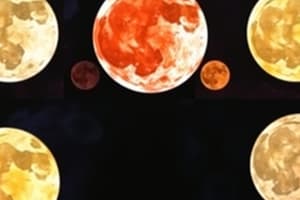Podcast
Questions and Answers
What are some of the main components found on the lunar surface?
What are some of the main components found on the lunar surface?
Aluminum oxide, silicate minerals, iron, magnesium, calcium, and glass particles
How does the lunar regolith differ from regular soil on Earth?
How does the lunar regolith differ from regular soil on Earth?
It is fine-grained and contains small quantities of titanium and manganese.
What significance does the moon hold in terms of Earth's stability?
What significance does the moon hold in terms of Earth's stability?
It helps maintain Earth's axial tilt and generates tidal forces.
How has the moon aided human development over time?
How has the moon aided human development over time?
What would potentially happen to Earth's climate without the moon?
What would potentially happen to Earth's climate without the moon?
Which country achieved the first manned lunar landings?
Which country achieved the first manned lunar landings?
When is the moon thought to have formed?
When is the moon thought to have formed?
What is the approximate mass ratio of the moon to Earth?
What is the approximate mass ratio of the moon to Earth?
How long does it take for the moon to orbit around Earth?
How long does it take for the moon to orbit around Earth?
How have lunar phases impacted various aspects of human culture?
How have lunar phases impacted various aspects of human culture?
What recent observations suggest the presence of on the moon?
What recent observations suggest the presence of on the moon?
What significant event led to the formation of the moon?
What significant event led to the formation of the moon?
Flashcards are hidden until you start studying
Study Notes
Introduction
The moon, our closest neighbor in outer space, has captivated human imagination and interest since the dawn of civilization. From mythical goddesses of the sea to modern technological feats, the lunar sphere has played various roles throughout history. Despite being the fourth largest moon in our solar system, Earth's only natural satellite exerts profound effects on our planet, shaping everything from ocean tides to the weather patterns on land. Let's explore some key aspects of this celestial body.
Formation of the Moon
The moon is thought to have formed around 4.5 billion years ago. Scientists believe that during Earth's infancy, an enormous collision occurred between the young earth and another massive object about the size of Mars. This cataclysmic event scattered debris across space, which then coalesced under the influence of gravitational attraction, forming the beginnings of what would become the moon.
Physical Characteristics
The moon is significantly smaller than Earth, having about 1/4 of its mass. It orbits around Earth once every 27.3 days, and their axial tilts are similar, leading to lunar phases visible from Earth. These cycles have contributed greatly to religious rituals, art, literature, and culture worldwide.
Although the lunar surface appears airless and lifeless, recent observations indicate the presence of ice deposits in permanently shadowed craters close to the poles. Additionally, global mapping reveals that the lunar terrain varies widely, ranging from vast plains to high mountains nearly three kilometers tall.
Composition and Atmosphere
The lunar surface consists mainly of aluminum oxide, silicate minerals, iron, magnesium, calcium, and glass particles created from ancient volcanic eruptions. The lunar regolith (soil) is fine-grained, containing small quantities of titanium and manganese among others. The moon lacks a substantial atmosphere, allowing dust and other debris to persist on its surface for millions of years.
Importance of the Moon
The moon serves multiple purposes within our solar system. It helps maintain the stability of Earth's axial tilt and is responsible for tidal forces that generate ocean currents. Furthermore, its predictable movements have enabled humans to develop calendars and navigate by stars.
However, the most striking aspect of the moon is its role in shaping life on Earth. Without the moon, the climate might have oscillated wildly, potentially rendering Earth uninhabitable. Consequently, due to the gradual recession of the lunar orbit, life forms on Earth have had ample time to evolve and adapt, ensuring the continuation of biological processes.
Human Interaction
Human interaction with the moon dates back to antiquity. Various cultures attributed supernatural powers to it, often linking them to fertility rites and stellar constellations. In more recent times, technological advancements have facilitated exploration and scientific discovery.
Space exploration began in earnest in the late 20th century. The United States became the first country to achieve manned lunar landings through the Apollo program (1969–1972), during which astronauts walked on its surface and gathered valuable geological data. Today, numerous international organizations continue exploring the moon, aiming to expand our understanding of this mysterious body and preparing to establish permanent bases there.
In conclusion, the moon's unique characteristics and importance have made it a subject of fascination since time immemorial. Through advancing technology and growing scientific understanding, human knowledge and interaction with this majestic celestial body are poised for further expansion in decades to come.
Studying That Suits You
Use AI to generate personalized quizzes and flashcards to suit your learning preferences.




